Ezra Firestone Makes $30 Million A Year. Here's How He Does It.
Ezra Firestone was doing ecommerce marketing long before Facebook was the go-to channel.
He spoke to us at Start Yours on the key to business success today, how ecommerce marketing has evolved, and what entrepreneurs should focus on in 2020.
If you’re short on time, here’s a five-point TL;DR version:
1. Algorithms today are so smart that you don’t really have to worry about placement or audience optimization. What you should focus on is the ad creative.
2. True wealth creation does not come from operating cash flow businesses. It comes from the liquidation of assets.
3. Focus on creative optimization and campaign objective optimization to be successful in 2020.
4. You need a 12-month business liquidity cushion to play the long game, not the 30- to 60-day cushion most businesses have.
5. Set boundaries and invest in your personal life, relationships, social life, and health to avoid burnout.
Start Yours is a podcast about ecommerce, dropshipping, and all things launching a business.
Join us as we meet entrepreneurs who have gone through the triumphs and headaches of running an online store, and learn how they managed to survive and thrive.
David: So, Ezra Firestone, welcome! One of the reasons that we are so excited to have you on Start Yours to talk out about Facebook advertising is that you have been marketing ecommerce stores since before Facebook was even really a big deal. So you have this decade positive experience, which is like a century in ecommerce years, and we’re gonna dig into that background here in a minute.
But before we look back, I wanna start by looking forward, and asking you what you’re most excited about when it comes to Facebook marketing and Instagram marketing in 2020. So, if that’s new tools that are available, or trends that you’re seeing emerge, new tactics. Whatever the case may be, what should people be jazzed about when it comes to Facebook and Instagram in 2020?



Opportunities to Scale
Ezra Firestone: Yeah man, thanks for having me on. And, you know, the game has evolved. It has changed a lot, and there has been a real kind of flip upside down in the last 24 months, where when you wanted to scale previously, it was all about optimization of your target audiences, and you could have kinda one piece of creative that you ran for six months to a year, or even longer. And you really just had to dial in the groups of people whom you were putting your ads in front of, and now it has completely shifted.
→ Click Here to Launch Your Online Business with Shopify
And now, you don’t really have to worry about the optimization of placements or audience as you scale because the algorithm is so smart. What you have to worry about is the optimization of your creative. Creative is, by far, the most important thing in advertising, contextual advertising, which Facebook and Instagram and YouTube fall under, whereas advertising like Google AdWords, or Amazon, or Pinterest, that’s query-based or search-based advertising, which is where advertising started, it started with search intent and queries.
When I got into the game, there was no contextual advertising. I.e., The difference being, you know, with contextual advertising, we have data points on people. So, Facebook has thousands of data points on you. They know who you are, what you buy, who your friends are, where you travel. And then we, as advertisers, can aggregate those data points and build groupings of people to put messages in front of.
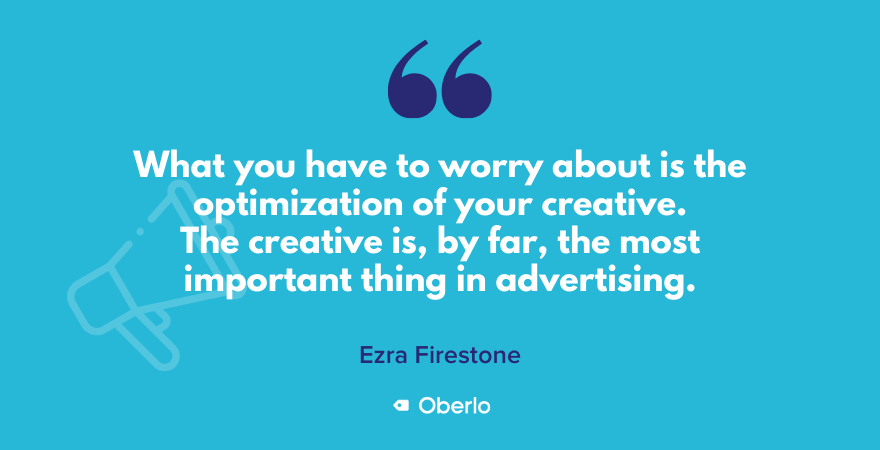
And that shift in advertising online is really what made… What really changed how brands can scale because now you don’t need to wait for someone to search for something. But it is a bit of a problem because contextual advertising is modern-day interruption advertising, much like ads in newspapers or magazines, where someone is reading a magazine or a newspaper and you’re interrupting them up with an ad. It’s just the online equivalent of that.
And the problem that that presents is that you have to get good at telling stories, at making videos, at creating ads that are gonna be compelling to get people’s attention. And I think that’s actually really exciting because it can set you up. If you get good at that, you can be set very, very, very far apart from your competition.
As an example, I’ve got one campaign right now that’s spending $22,000 a day on Facebook top line awareness, getting new people to know about me, at a 2x return on ad spend.
So, I’m having my best performing advertising ever on Facebook in 2020. And that’s because of the fact that creative is more important than it has ever been, and I’m really good at storytelling, understanding the desires and experience of my consumers, and talking to them about it.
Ezra Firestone’s Take on Ecommerce Marketing 10 Years Ago
David: Now, at the end of the podcast, I’m gonna ask you the opposite of what I just did, and that’ll be: What makes you nervous about Facebook marketing in 2020? But let’s put a pin in that for now, so I can unpack your backstory a bit.
You mentioned that you’ve been doing this for a while, so you got into ecommerce, I believe, it was in 2007, then in 2010 you launched BOOM by Cindy Joseph, which is a cosmetics line that you helped scale into an absolute powerhouse. And then, in 2012, you sold that first store, and really you’ve just kept things rolling ever since.
What’s crazy, though, is that by 2012, you had already racked up five years of ecommerce experience, and you were really at the cutting edge of a lot of the channels that today are just kind of taken for granted. And that’s so cool because understanding the present, I think, gets much easier when you understand the past. So, I won’t ask you to break down that ‘07 to ‘12 era, year by year. But if you could just kinda give us a snapshot of what digital marketing was like, back in those days. What were the core components of a really good 2010 paid marketing mix?
Ezra Firestone: Yeah, man, I actually got into the game in 05. I was selling cheese on Commission Junction.
David: Okay. I short-changed you, okay.
Ezra Firestone: Yeah, I’ve been in it. So, you know that first era, like I was mentioning, there were two forms of visibility. There was Google AdWords, pay-per-click, where you were paying for people who were searching for queries on Google, and there was search engine optimization, where you were ranking on Google.
And it was all search traffic, it was all query-based traffic, and the only brand asset that was available was an email address. We didn’t have Facebook Pixel, you couldn’t re-target people. There weren’t such things as messenger subscribers, you didn’t really have social media fan pages, where you could build up audiences.
So, you didn’t have any assets, other than the email list. So the game was about optimizing your brand so that Google would consider you the most relevant for a given search query and then collecting an email address, so you could email people. It was a much simpler time, it was wonderful, it was a great time.
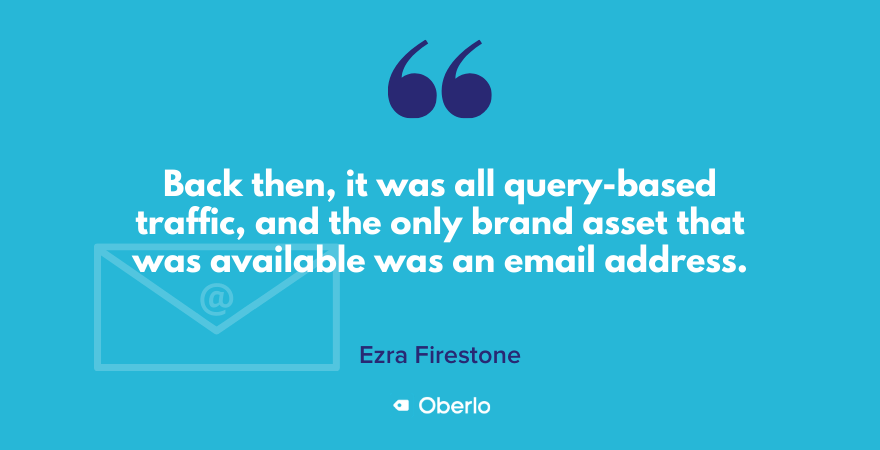
The problem was that you were limited to query-based traffic. I mean, contextual advertising existed, inasmuch as you could run an ad. You know, it was Google… It was called the content network, back then. You could… Which is now the display network. You could run an ad to someone, but the only piece of context you had on them was the type of page they were visiting.
So, if they were on a page about cats, you could run an ad about cats. So, it was really hard to make contextual advertising work back then. But it was a fun time, it was a really wonderful time for ecommerce. Dropshipping didn’t exist in China, you couldn’t… There was no Alibaba, no AliExpress, none of that stuff. So, the way that dropshipping worked was with American suppliers.
And I actually got started right around the same time, as Wayfair. You’re familiar with Wayfair, right?
David: Okay. Sure. Yeah, yeah.
Ezra Firestone: Wayfair was one of the biggest dropshippers in the world, a multi-billion dollar a year organization. They started around the same time I did, doing the same thing I was doing, which was buying exact match domains like giftbaskets.com com and dogsupplies.com, ranking them on Google for relevant product-based queries, building a Yahoo store, so I could receive orders, receiving those orders from people who were searching for those queries, and then faxing an American dropshipper saying, “Hey, I just got an order for three bar stools, and they paid me 100 bucks. I’m gonna pay you 50 bucks, and you ship them out.” So, it was all done via fax, and it was great.
And, at that time, I didn’t understand delegation, I didn’t understand systems and infrastructure, I didn’t understand “team”.
And so, at the height of my dropshipping, I only ever had like 12, maybe 20 stores max, whereas Wayfair had hundreds. And they were much more evolved business folks than I was at that time. I was really, really young, I was like 19 or 20, and they…
You saw what they scaled it into. So I always felt like I could have been Wayfair if I understood what I understand now. I could have made my dropshipping of Empire a little bit bigger. As you mentioned, I did sell my most profitable dropship company in 2012. It was a costume wig business. I hold the record for being America’s number one mullet wig retailer in ’08 and ’09.
David: All right!
Ezra Firestone: So, that’s kind of fun. So yeah, I don’t know, I could tell you more about that era but it was a good era but it was limited.
Marketing Fundamentals Have Not Changed
David: So what are… When you look back on that in over the last decade-plus through today, what are some of the things that have been constant throughout? I assume good copy never goes out of style. I assume that…
Ezra Firestone: Dude, nothing has changed. Nothing has changed.
David: Okay.
Ezra Firestone: Everyone’s all, “I’m too late to the game and everything’s different every month.” It’s like, “No, here’s what you need. Okay, I will give you business tips for how to be successful in business.”
You need a truly remarkable product, like good products that are actually gonna help people, that people like, that when they get them, they’re happy with.
So you gotta have the product done well, and your product has to be good so that when someone gets it, they’re happy with it. You gotta have good support which means you need to reply… You need to be available to be reached via live chat like a Facebook chatbot. You need to be available to be reached via the phone, you need to be available to be reached via email, you need to get back to people in business hours within an hour, you need to respond to them, you’ve gotta have super high-quality customer service support because that is how you end up with repeat business which is very, very important in ecommerce.
And then you need good marketing, that’s it. Product, support and marketing, and marketing has sort of changed a little bit over the years inasmuch as the traffic sources have changed like it was all Google AdWords, SEO, and now it’s all Facebook, Instagram, and YouTube and display… I mean, there are a lot of traffic sources now, but the game has changed but you’ve always been able to go to the traffic store and buy traffic.
So, what do you need to be good at? Storytelling. And in this day and age the way you tell stories, it used to be… It was search, find, buy. So where you told your story was on the product page. Someone searched for you, they found your ad or they found your organic listing, they clicked on it, and then they went to your product page where you did all your selling.
Well, now all of the selling is happening higher up in the sales funnel. It’s happening via your video ads on Facebook, your video ads on Instagram, your retargeting ads on the display network that lead to articles. All the selling is happening before they get to the product page.
So what you have to get good at now is telling a story in the context of native social video which is easier, frankly, than the way that we used to do it which is you have to tell your story via text and images on a product page where nobody scrolled. So, nothing has changed. The fundamentals always win.
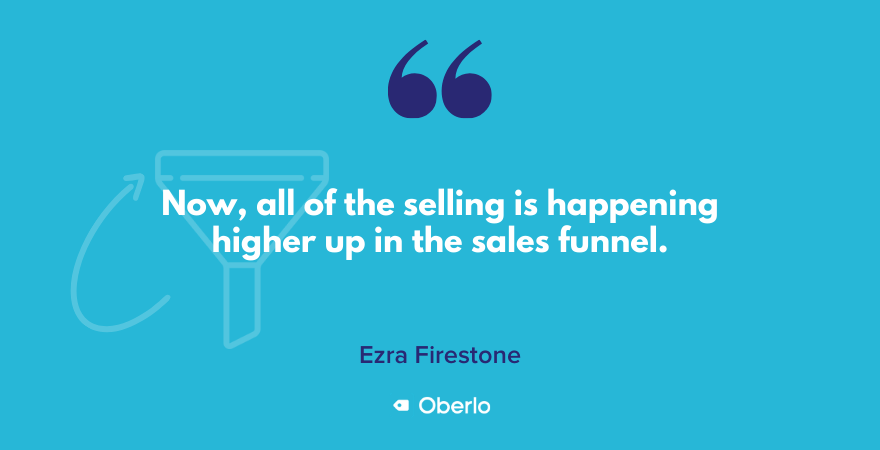
You listen to any Olympic athlete and any Olympic coach and they’re gonna tell you, “Focus on the fundamentals. The fundamentals win ball games, the fundamentals win,” and what the fundamentals are is good amplification, which is not that hard, and good creative which catches… Look, what you do in a business… I’m just gonna give you the formula for business.
David: Yeah, lay it on me.
Ezra Firestone: What you are doing is you are communicating with a group of people who are sharing a collective experience. You are then adding value to their life by commenting on that experience through content and providing a solution to a problem that that group of people faces.
For example, women over 50 whose hair is greying, whose skin is wrinkling, whose hormone is, hormones are changing, and everybody’s telling them they gotta change that, they gotta stop it, they gotta cover it up. And I’ve got cosmetics that are about celebrating them as they are now.
Dropshippers who wanna sell more products via Facebook ads. I’m creating a piece of content here that supports them that then leads to, in your case, go use Oberlo ’cause it helps you with that problem. You have a group of people who are collectively sharing an experience and you have a product that solves the problem for that group of people and you have to engage them, talk to them about the experience they’re having, demonstrate the solution you have to their problem and get them to go check out your stuff. That’s the game.
The Common but Misguided Approach to Business
David: You have an awesome course in the Shopify Academy and in there you break down some of your core marketing principles and number one on the list is be willing to spend, and I love that that’s number one because it doesn’t beat around the bush. The savviest copy are the most intricate targeting at all. It all kind of falls apart if people aren’t willing to spend.
So, you’ve worked with entrepreneurs for years and years, you’ve been an entrepreneur for years and years, have you seen an unwillingness to spend, kind of, handcuffs on people out of the gate?
Ezra Firestone: Yeah. Everybody’s misguided in their approach to their business. They’re all concerned with what can they get out of it, how much money can I make, what can I pull out? That is short-sighted and that’s misguided. The question to ask yourself is, “What can I invest?”
Think of it like a garden where you, most people are going out, they’re trying to spear a fish and they’re trying to eat, and that’s what dropshipping is, frankly, in my opinion, what most people who are dropshipping are doing.
The better analogy is farming. You wanna water your garden every day for a year and build assets like pixel-ed audiences, email addresses, customer databases. And then you want to take all the money that you’re making and reinvest it right back into the brand so that the snowball grows. So that by the time you pull from the snowball, it has enough to support you rather…
What happens is people are watering their garden, they’re watering their garden, the seed sprouts, it’s starting to come up, and it’s about to break through the soil and then they rip it out and try to eat it.
It’s like, “No, you gotta let it continue to grow and let it become an actual mango tree that then can feed you for generations by reinvesting all of the energy from the asset back into itself.” People wanna ball out on Instagram and drive Lambos and freaking wear funny hats, and do all that shit, which is fine. But it’s like, “Listen, do that once you actually have something that is stable, don’t pull from the asset too early,” which is what most people are doing.
And with advertising, it takes time. It’s like a diet or a workout program, you can’t start it and stop it, you gotta do it every day, you have to pick an amount of money you’re gonna spend, commit to a year, and spend that money every day, and your assets will grow. And if you don’t do that, you’re gonna end up never getting where you wanna go. So I think that just the approach that most people are taking is a completely misguided approach. It’s all about what they can get out rather than what they can invest.
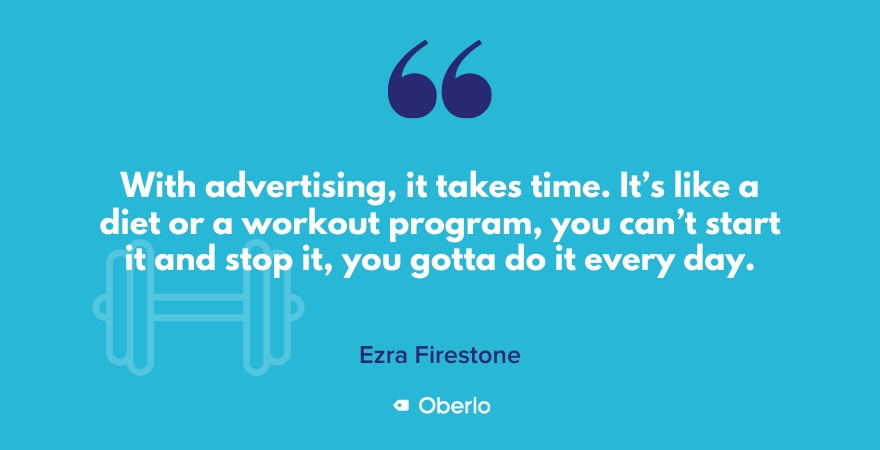
The Root of Wealth Creation According to Ezra Firestone
David: And you’re an advocate of the idea that when you spend money on advertising, you’re not only spending money to acquire customers, but you’re also spending money on data, and you’ve mentioned the pixel a couple of times and I think that this is super important for people to understand and to keep in mind.
And this idea that you’re buying data has come up before in the Oberlo Podcast, and I know that it’s absolutely true, but I can also imagine that to someone who’s just starting out maybe it might sound a little nuts. So what would you say to somebody who gets a little nervous, a little queasy with the idea that they should be okay not generating sales with certain ads because really the data that they’re getting is just as cool?
Ezra Firestone: Let me ask you about any other business model in the world. Do you have to invest before it works? Do you have to go and lease a shop and then do you have to build that shop out and then do you have to go and buy all the food that you’re gonna sell people and then do you have to go and run ads on Google and run a marketing campaign to get people to come in?
Yeah, you gotta invest. People are spoiled in this dropshipping world where they’re like, “Just turn on the ads and you’re gonna make sales.” Sometimes it works that way, more power to you. But where else can you take $500 to $5,000 and invest that in learning a market, learning what people are interested, testing ads, and potentially from that investment have $100,000 or more dollar per year business.
And you don’t get that kind of return in anywhere else, and people don’t wanna spend the $500 to five grand and I’m like, “Okay, you’re never gonna make it and get out of this business ’cause this isn’t for you, you’ve been sold some get rich quick scheme by someone who wanted to take $97 from you for some course.” And it’s like that’s not how it works.
You have to understand that the goal in business is to create assets because listen, at the end of the day, if you wanna talk about wealth creation, you’re never gonna get there from a cash flow business. Our parents’ generation understood wealth creation.
Wealth creation, true wealth creation does not come from operating cash flow businesses. It comes from the liquidation of assets.
Our parents’ generation understood this and what they did was they took the money from their 401Ks as a generation, they invested in real estate, they let that asset appreciate and then they sold those assets to generate real wealth that they could then deploy back into the market for more real estate or buy-in businesses or trust or whatever they wanted.
Our generation doesn’t understand this. Our generation thinks the way that you make money is that you run a dropshipping business and sure, you could make some cash flow. But 85 percent of the money you’ll ever make on a business comes the day you sell it.
When you sell a business, what are you selling? You’re selling the assets that the business has, the customer database, the pixeled audiences, the products, the suppliers, the ad accounts, right? So the goal should be to take all the money you’re making in your business, reinvest it back into the business so that you’re developing the largest asset you possibly can, and then to sell that asset for a one to three multiple of the yearly profit and then to take that money and use that to buy businesses, build businesses, invest in real estate, do whatever you want, that is how you truly generate wealth. It’s not from a cash flow business.
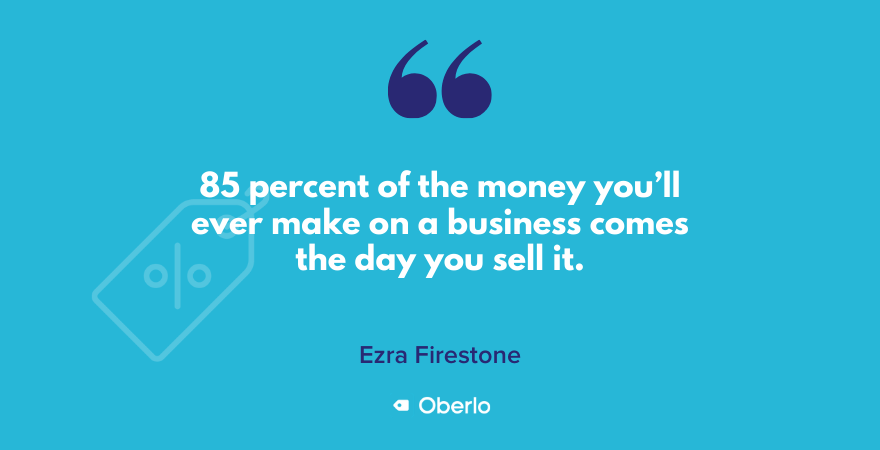
Tackling Facebook in 2020
David: Doubling back to Facebook now, I’m curious if you think there’s any low-hanging fruit left when it comes to Facebook marketing. I know you like to say that secrets are truth hiding in plain sight, which is a great, great way to look at it.
But there are so many marketers flocking to Facebook, there are so many eyeballs looking for these simple truths and they have been for years and years, and so it seems like it might be a purely efficient system at this point. But maybe are there any settings or geographies, or formats or copy hacks, whatever it might be that people should be testing out in 2020?
Ezra Firestone: So I think the thing to understand about Facebook is that each individual is a number in the eyes of Facebook. That’s it. Just a number, and that number, that profile number is going to be shown a certain amount of conversion ads, campaigns that are optimized for conversions, a certain amount of ads from campaigns that are optimized for catalog sales, a certain amount of ads from campaigns that are optimized for video views, a certain amount of ads from campaigns that are optimized for page post engagement, a certain amount of ads from campaigns that are optimized for brand awareness, for web traffic, etcetera.
Most dropshippers are only running conversion campaigns. Well, what happens is then you only are reaching that person 40 percent of the amount you could be reaching them. The CPMs on the other campaign objectives are significantly lower, so you must be spending 20 percent of your marketing budget on non-conversion focused activities that will, like brand awareness, video views, page post engagement, optimization for the lead objective to generate emails because you’ll reach more of the same audience that’s converting for you with your conversion campaigns for cheaper.
The other thing you must do is you must have creative that’s optimized for every placement.
So you gotta have long-form video, short-form video, sub-15-second video, sub-120-second video, bigger than 120-second video. You gotta have four-by-five ratio videos, one-by-one ratio videos, you gotta have image ads, you gotta have GIF animation ads ’cause again, someone’s only gonna see a certain amount of video, certain amount of images, certain amount of gifs, so you really have to focus on creative optimization and campaign objective optimization to be successful in 2020.
David: You’ve mentioned video a couple of times and I know that things are really trending towards video and I’m wondering how high you think the bar is for what’s a reasonable quality video? Is talking to me on the phone…
Ezra Firestone: I’m spending $22,000 a day on videos that are shot on an iPhone with no fancy equipment. Native video is best, natural, real, looks authentic, that is working best for me. It doesn’t have to be fancy.
Ezra Firestone, the Poker Player
David: Now you played poker a lot back in the day and I think this was even before poker was cool, before it was on TV and all of that. And I don’t wanna do too much psycho-analysis here. But do you think that your background of playing poker might have helped you in your early ecommerce days? And I know that these things are obviously different but it seems like having an appetite for risk and for making educated gambles that that might have served you well when it came to online advertising?
Ezra Firestone: You know, I think that one of the things that most entrepreneurs have is a very high-risk tolerance, and in order to be a successful poker player, yeah, I came up playing cards in the New York City underground, I was playing with guys like Vinnie the Limo and Johnny Two Tone, and Joey Cupcakes and guys like that, and they called me, “Johnny how you doing.” Long story.
But yeah, in order to be successful at poker, you gotta have a high-risk tolerance, and I think in order to be successful as an entrepreneur… You know, most entrepreneurs, myself included, my risk tolerance is, I mean, off-the-charts different from your average person who’s looking for security, and I’m willing to take risks, big risks. ‘Cause then I think you need to have that to be a successful advertiser, or a willingness to stretch in that realm.
And if that’s uncomfortable for you, go get a job and get some security, because you know what doesn’t have security? Entrepreneurship. You know what has all the pressure in the world? Entrepreneurship. Because everything is riding on you, everybody’s salaries that you have to pay, the success of the company, all of it. You’ve got no security, you just have your own grit, determination, and willingness to continue to show up and move in the direction of your goal, with a positive attitude.
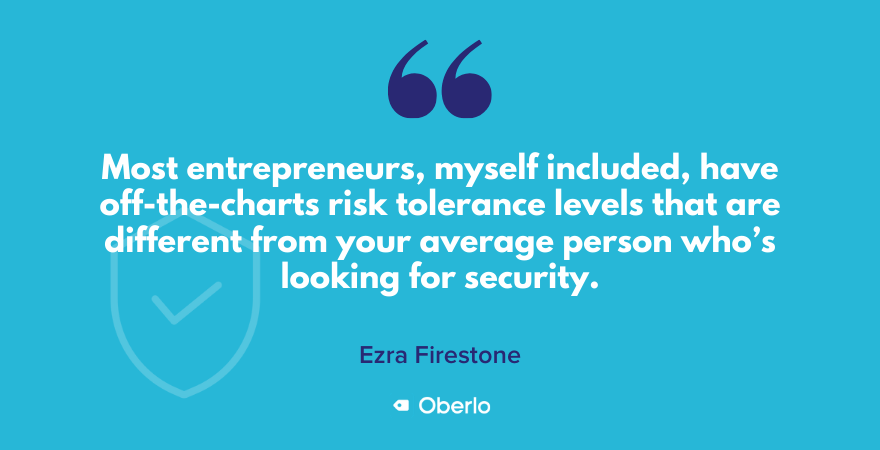
And it’s gonna be intense. You’re gonna be the end of the line for everything, everything’s gonna be riding on your shoulders, and you’re gonna have to push all your chips in, when you’re not 100 percent sure, quite often, and make those calculated risks. And so, yeah, I think risk tolerance is a big factor when it comes to entrepreneurship.
Business Liquidity Cushion
David: And so, there’s no set up where you can be both an entrepreneur, trying to kinda make things happen and… Okay.
Ezra Firestone: Use someone else’s money. You could use someone else’s money…
David: Sure.
Ezra Firestone: That helps… These ventured-back companies, they’re all going out of business, Casper, and Brand List, because they were using someone else’s money, and they didn’t care. I like using my own money ’cause then I really, really care. And, you know, yeah, listen, as… Look, as you scale, you start to understand things like the cushion, right?
For example, I think that you’re not safe unless you have two years of liquidity for your life.
So, let’s say that you and your family live on $100,000 a year after taxes. That’s what you feed your family with, pay for your healthcare, pay for your mortgage. Let’s just say, that’s pretty high for most families. But say you live on 100 grand a year, after taxes. You need 200 grand liquid in a bank account, so that if shit hits the fan, you had two years to rebuild.
And most people are operating on a 15- to 45-day window of liquidity in their bank account. And most people are actually operating, if you look at the… I’m talking about people in our community who are entrepreneurs, who have money and stuff, but those folks only have a 15- to 45-day window of liquidity, at any given time, for the most part, and most people don’t have any. They’re negative, in debt.
So I think that, from a personal standpoint, one way to fortify yourself is to have personal liquidity, in case you get sick or something goes down. And then, you also wanna have business liquidity, where you’ve got 12 months of operating capital, at any given time, in your business bank account. So, 12 months of what inventory cost, 12 months of what staff salary cost, 12 months of what advertising cost.
And there’s almost no business out there who has that. Most businesses are operating on a 30- to 60-day liquidity cushion. And so, if you want to lighten the load on yourself, and you wanna play the long game, and you start to understand finances, then you increase your liquidity windows, in the direction of having a cushion for things not going the way that you hope they go, which happens in business, it’s up and down. So, that’s one way to do it, I do that, and I’m very fiscally responsible in that way, and it’s one of the reasons why I can be so aggressive.
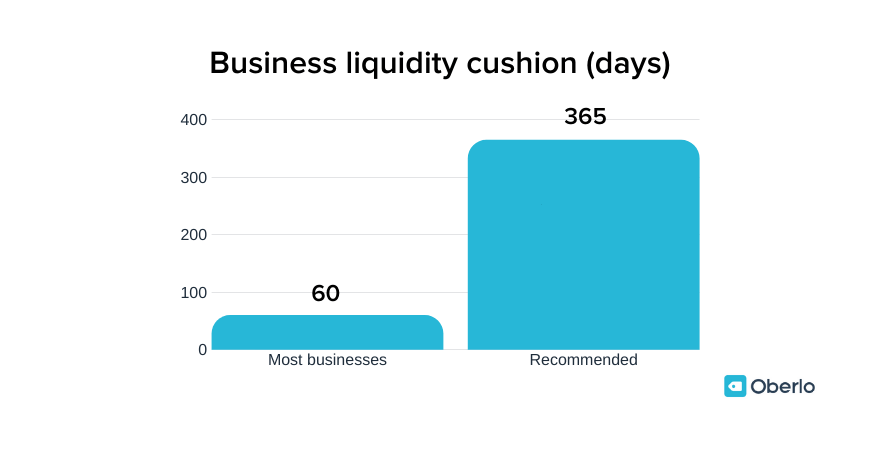
Avoiding Entrepreneurial Burnout
David: You’ve talked and written about burnout, and you’ve said this is the most common reason people fail in business, and you have a great quote where you say, “The game is about consistency, not intensity.” And I’m curious where that mindset comes from and if that’s something you had to learn the hard way, or if this is… You know, that was just your approach from day one.
Ezra Firestone: Well, I’ve seen it happen to so many friends of mine. I’ve been in this industry since 2005, and the most common thing that I see happen is entrepreneurs burn out. They overwhelm themselves with too many cycles. They don’t take care of their physical body, they don’t take care of their mental body, they don’t have a social life, they don’t focus on their relationships, they put all their energy into their business.
And then, they associate their own value, as a person, with the success of the business, and so their identity is wrapped up in the business’ success. And then, if the business isn’t going well, they are miserable, unhappy, and feel worthless. And they don’t have anything in their life outside of business. And then, because they are sacrificing for their family, and whatever bullshit they’re telling themselves.
But then, they’re not showing up for their family because they’re overworked, overwhelmed, they haven’t taken care of their body, they haven’t put any attention on their social life or the relationship. So, by the time they get home, they’re an empty cup, and they’ve got nothing to pour from.
And I’ve just seen it happen so much, and I got lucky, I became an entrepreneur when I was… I’ve always been an entrepreneur, but I started my own business when I was 19. And so, I’ve been in the game, and so all those years where I was grinding, I was young, and I had the energy for it, and I didn’t have any responsibility. And I learned, in my early 20s, after seeing it happen, I was like, “Man, I really need to invest in my life outside of this business, because I can see the trappings of… You know, it’s digital. I can think about it all the time, I can’t escape it, because I can put attention on it anytime I want.”
I’ve got to set clear boundaries around my work life, or this is gonna take over my entire world. And look, sometimes that has gotta happen because you’re running launches and stuff like that. But if the backdrop of your life is 24 hours a day business, you’re gonna burnout and it’s not gonna work out for you.
And look, I’m playing the long game. There’s a reason why I am making $30 million a year in revenue 15 years in. I’m doing the best I’ve ever done, I’ve got… I’m happy, I’ve got a social life, I’m taking care of my body, I’m investing in my relationship. There’s a reason why I’m doing all that because that’s actually the best thing you could do for the business… In addition, too, I wanna enjoy my life, and not just be a workaholic. It actually ultimately serves my goal of… Then, I have the energy for the business. Then, I’m forced to learn to delegate, because I can’t do it all myself.
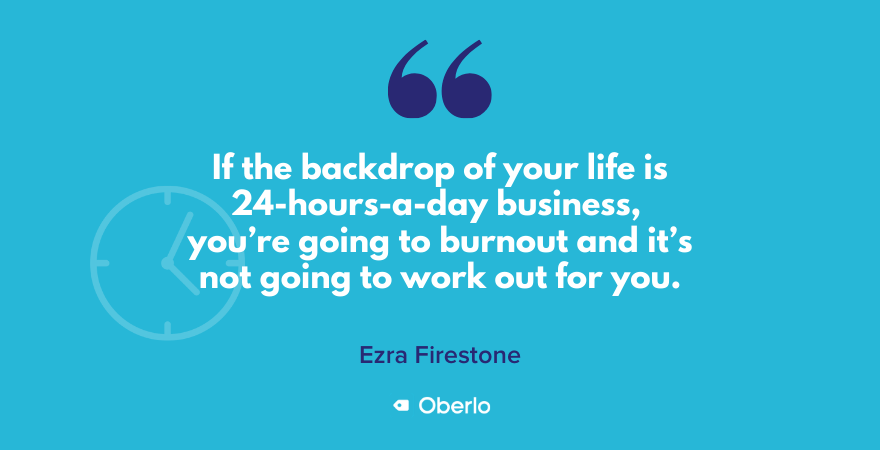
It’s like the best thing you could possibly do is invest in your personal life, invest in your relationships, invest in your social life, take care of your body, set borders around your work. You think that it’s going to hold you back, but it actually turns out, after eight hours in a day, your productivity drops by like 180 percent. So, it actually turns out that if you’re putting in six to eight hours a day, four or five days a week, that’s plenty.
Yeah, so it’s kinda like… It’s in the best interest of the long game, which is what I’m playing. I wanna be doing this for another 10 years, another 15 years, another 20 years. And, in order to achieve that, to really build something of value, I need to be able to show up every day, consistently, with a positive attitude, with energy and take the next step in the direction of my goal. I’m not sprinting. And people who sprint, fall apart. And I don’t wanna fall apart.
Ezra Firestone’s Take on Over Reliance on Facebook
David: All right. We teased it at the beginning, and now I’ll get you out of here with this. Let’s double-back around to Facebook, where we started. And we talked about what you were excited about then, and let’s talk about what you’re nervous about now when it comes to Facebook and Instagram. Maybe nervous isn’t the right word, but what’s something that you see bubbling up, that you think might cause a few headaches if people aren’t ready to adapt?
Ezra Firestone: Well, I think it’s the same thing I told you about, which is creative. I’m nervous about having to continue to optimize creative, it’s hard. It takes time, it takes energy, it takes effort. It’s wonderful because it’s doable, but it’s also nerve-wracking because if you don’t do it, you’re gonna fall apart. Whereas before, you just had to optimize audiences, and that was a lot easier, and placements and stuff like that.
I also think that too much of a reliance on Facebook is bad. So, in 2018, I was 95-5, Facebook to Google. In 2019, I was 75-25 Facebook to Google, and in 2020, I’m 60-40. So, I’m investing a lot in YouTube, a lot in the Google Display Network, a lot in Google Search, a lot in Gmail, right? Because I wanna have some level of diversity off of Facebook.
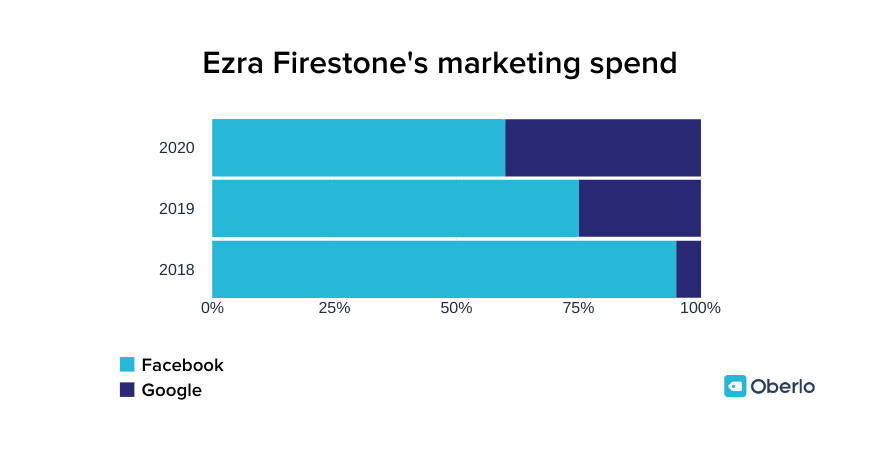
David: It makes sense, all right. Ezra, we can leave it there. Thanks so much for joining us. If you wanna check out more from Ezra Firestone, go to smartmarketer.com. He has also got videos on YouTube, and good stuff in various corners of the internet.
Ezra Firestone: Yeah, and one quick thing I will say is, if you’re a dropshipper, go to, and you’re on Shopify, check out Zipify pages. It’s a landing page builder I made for Shopify, and it will increase your conversions considerably.
David: All right, cool. Ezra, thank you so much.
Ezra Firestone: Hey man, thanks for having me on, I appreciate it.


